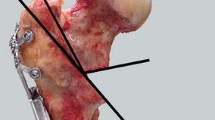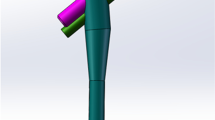Abstract
Purpose
Proximal femoral fractures are among the most commonly sustained fractures. The current treatment of stable proximal femoral fractures located in trochanteric region primarily involves the use of two systems: extramedullary dynamic hip screws and intramedullary hip nails. Given that these fractures are mainly found in the elderly population, the necessity of a repeat, due to failure of the first, may jeopardize the patient’s life. Decisive factors contributing to the healing of a fracture (or the failure thereof) include fracture pattern, technical implementation of the operation (i.e., position of the implant), implant’s properties and its changes in relation to the surrounding bone tissue during loading. Each screw insertion variant results in damage to various load-bearing bone structures, which can be expected to influence healing quality and stability of newly formed bone.
Method
With the aid of a numerical model and finite element methods, the authors analyzed several different positions of IMHN/PFH-nails in the proximal femur, with the objective of determining positions with an increased risk of failure.
Results and conclusion
In model situations, it has been shown that in stable fractures results do not depend on absolutely precise positioning and small deflections in the nails and neck screws positions do not significantly increase the risk of failure for the entire fixation. Damage to load-bearing structures relative to various implant placements does not impact the resultant overall fixation stability. Therefore, it is not necessary to re-introduce implants in the ideal position, which can lead to reduced patient radiation doses during surgery.





Similar content being viewed by others
References
Baca V, Kachlik D, Horak Z, Stingl J (2007) The course of osteons in the compact bone of the human proximal femur with clinical and biomechanical significance. Surg Radiol Anat 29(5):201–207
Baca V, Horak Z, Mikulenka P, Dzupa V (2008) Comparison of isotropic and orthotropic material property assignments on femoral finite element models under two loading conditions. Med Eng Phys 30(7):924–930
Bartoska R, Baca V, Kachlik D, Marvan J, Dzupa V (2013) The correlation between muscles insertions and topography of break lines in pertrochanteric fractures: a comprehensive anatomical approach of complex proximal femur injuries. Surg Radiol Anat 35(10):957–962
Chang KP, Center JR, Nguyen TV, Eisman JA (2004) Incidence of hip and other osteoporotic fractures in elderly men and women: Dubbo osteoporosis epidemiology study. J Bone Miner Res 19:532–536
Dousa P, Cech O, Weissinger M, Dzupa V (2013) Trochanteric femoral fractures. Acta Chir Orthop Traumatol Cech 80(1):15–26
Endo Y, Aharonoff GB, Zuckerman JD, Egol KA, Koval KJ (2005) Gender differences in patients with hip fracture: a greater risk of morbidity and mortality in men. J Orthop Trauma 19:29–35
Hesse B, Gächter A (2004) Complications following the treatment of trochanteric fracture with gamma nail. Arch Ortho Trauma Surg 124:692–698
Helwig P, Faust G, Hindenlang U, Hirschmüller A, Konstantinidis L, Bahrs Ch, Südkamp N, Schneider R (2009) Finite element analysis of four different implants inserted in different positions to stabilize an idealized trochanteric femoral fracture. Injury. Int J Care Inj 40:288–295
Holt G, Smith R, Duncan K, Hutchison JD, Gregori A (2008) Gender differences in epidemiology and outcome after hip fracture: evidence from the Scottish hip fracture audit. J Bone Jt Surg 90-B:480–483
Hrubina M, Skotak M, Behounek J (2010) Complications of dynamic hip screw treatment for proximal femoral fractures. Acta Chir Orthop Traumatol Cech 77(5):395–401
Hrubina M, Horak Z, Bartoska R, Navratil L, Rosina J (2013) Computational modeling in the prediction of dynamic hip screw failure in proximal femoral fractures. J Appl Biomed 11:143–151
Hsueh KK, Fang CK, Chen CM, Su YP, Wu HF, Chiu FY (2010) Risk factors in cutout of sliding hip screw in intertrochanteric fractures: an evaluation of 937 patients. Int Orthop 34:1273–1276
Kachlik D, Bozdechova I, Cech P, Musil V, Baca V (2009) Mistakes in the usage of anatomical terminology in clinical practice. Biomed Pap 153(2):157–161
Keyak J, Falkinstein Y (2003) Comparison of in situ and in vitro CT scan-based finite element model predictions of proximal femoral fracture load. Med Eng Phys 25:781–787
Keller T (1994) Predicting the compressive mechanical behavior of bone. J Biomech 27:1159–1168
Kopp L, Edelmann K, Obruba P, Prochazka B, Blstakova K, Dzupa V (2009) Mortality risk factors in the elderly with proximal femoral fracture treated surgically. Acta Chir Orthop Traumatol Cech 76(1):41–46
Lenich A, Vester H, Nerlich M, Mayr E, Stöckle U, Füchtmeier B (2010) Clinical comparison of the second and third generation of intramedullary devices for trochanteric fractures of the hip—blade vs screw. Injury 42:1292–1296
Les C, Keyak J, Stover S, Taylor K, Kaneps A (1994) Estimation of material properties in the equine metacarpus with use of quantitative computed tomography. J Orthop Res 12:822–833
Lešič A, Jarebinski M, Pekmezovič T, Bumbaširevič M, Spasovali D, Atkinson HD (2007) Epidemiology of hip fractures in Belgrade, Serbia Montenegro, 1990–2000. Arch Orthop Trauma Surg 127:179–183
Shih KH, Hsu ChCh, Hsu TP, Hou SH, Liaw ChH (2014) Biomechanical analyses of static and dynamic fixation techniques of retrograde interlocking femoral nailing using nonlinear finite element methods. Comp Meth Prog Biomed 113:456–464
Skala-Rosenbaum J, Bartonicek J, Bartoska R (2010) Is distal locking with IMHN necessary in every pertrochanteric fracture? Int Orthop 34(7):1041–1047
Skala-Rosenbaum J, Bartonicek J, Riha D, Waldauf P, Dzupa V (2011) Single-centre study of hip fractures in Prague, Czech Republic, 1997–2007. Int Orthop 35(4):587–593
Smektala R, Ohmann C, Paech S, Neuhaus E, Rieger M, Schwabe W, Debold P, Deimling A, Jonas M, Hupe K, Bücker-Nott HJ, Giani G, Szucs TD, Pientka L (2005) Zur Prognose der Schenkelhalsfraktur. Beurteilung der Mortalität nach Schenkelhalsfraktur durch sektorübergreifende Datenzusammenführung. Unfallchirurg 108:927–937
Trabelsi N, Yosibash Z, Wutte Ch, Augat P, Eberle S (2011) Patient-specific finite element analysis of the human femur—a double-blinded biomechanical validation. J Biomech 44:1666–1672
Werner-Tutschku W, Lajtai G, Schmiedhuber G (2002) Intra and perioperative complications in the stabilization of per- and subtrochanteric femoral fractures by means of PFN. Unfallchirurg 105:881–885
Wu CC, Shih CH, Lee MY, Tai CL (1996) Biomechanical analysis of location of lag screw of a dynamic hip screw in treatment of unstable intertrochanteric fracture. J Trauma 41:699–702
Yosibash Z, Katz A, Milgrom Ch (2013) Toward verified and validated FE simulations of a femur with a cemented hip prosthesis. Med Eng Phys 35:978–987
Acknowledgments
Supported by Internal Grant Agency of the Charles University in Prague GA UK 420411/2011 and Structural Funds EU OPPC CZ216/3100/24018.
Author information
Authors and Affiliations
Corresponding author
Ethics declarations
Conflict of interest
There is no conflict of interest.
Rights and permissions
About this article
Cite this article
Bartoska, R., Baca, V., Horak, Z. et al. The importance of intramedullary hip nail positioning during implantation for stable pertrochanteric fractures: biomechanical analysis. Surg Radiol Anat 38, 577–585 (2016). https://doi.org/10.1007/s00276-015-1595-4
Received:
Accepted:
Published:
Issue Date:
DOI: https://doi.org/10.1007/s00276-015-1595-4




